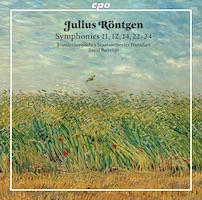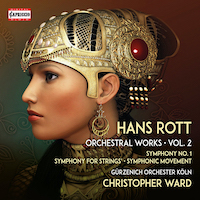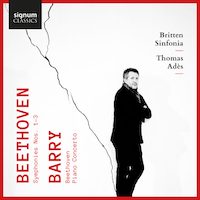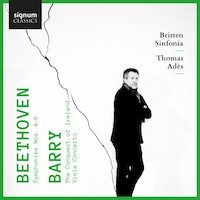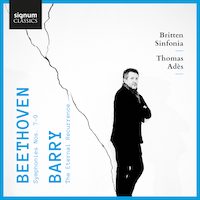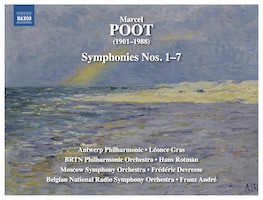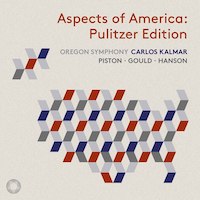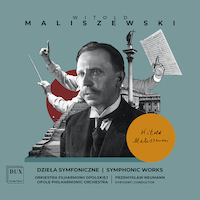Mostly Symphonies 40.
|
Grant Chu Covell [February 2022.]
Julius RÖNTGEN: Symphony No. 7 in F minor, “Edinburgh” (1930)a; Symphony No. 14 in D major, “Winterthur” (1930)b; Symphony No. 12 in C major, “In Babylone” (1930)c; Symphony No. 11 in G minor, “Wirbel” (1930)d; Symphony No. 23 in C minor (1932)e; Symphony No. 22 in F-sharp minor (1931)f; Symphony No. 24 in E major (1932)g. Brandenburgisches Staatsorchester Frankfurta,b,c, Helsingborg Symphony Orchestrad,e,f,g, David Porcelijn (cond.). cpo 777 309-2 (2 CDs) (www.cpo.de). Röntgen (1855-1932) wrote 24 symphonies, many of them relatively short and written incredibly quickly. 17 of them came from the last three years of his life when he was in his late 70s. This double set collects seven symphonies. Nos. 7 and 24 are four movements but are brief at 22 and 18 minutes respectively. The other five are single movements. No. 11 was written in two days, July 28 and 29 in 1930; No. 24 came into being on March 26, 1932. Röntgen is pithy and contrapuntal, fitting well into the tail-end of the Austro-Germanic curve that started with Beethoven and stretched outwards towards Mahler. There are bright harmonic moments that suggest Nielsen, but overall, these are quirky tonal efforts that may suggest outliers such as Leifs and Langgaard. No. 7 was written to acknowledge an honorary degree. Why do I pick up a sense of mania with Rontgen? (Only later did I recognize the cover image is by Röntgen’s compatriot Van Gogh.) A single-movement symphony can concentrate the ideas and streamline a flow. Or the music can wander through contrasting material and any return is perceived as tidy because of the shortened span. Other than hubris, nothing demands that a symphony should bloat or match Bruckner’s scale. Röntgen rhapsodizes quickly, orchestrates colorfully, and hovers securely within the framework of Romantic tonality. These sat in cpo’s vaults for quite some time (since 2006 for Nos. 7, 12 and 14; since 2007 for 11, 22, 23 and 24).
“Orchestral Works, Vol. 2.” Hans ROTT: Symphony No. 1 (1878-80); Symphony for String Orchestra (1874-75); Symphonic Movement in E major (1878). Gürzenich Orchester Köln, Christopher Ward (cond.). Capriccio C5414 (1 CD) (www.capriccio.at). Despite Rott’s short life (1858-84) and scant oeuvre, Mahler’s enthusiasm for his classmate invites us to fantasize about what could have been. Rott’s First rambles jubilantly and heroically, a pleasing combination of pre-Nibelungen Wagner (and Humperdinck) with surreal hints of the future Mahler. In retrospect, we can see similarities with others’ Firsts, and wish that Rott (1858-84) had lived long enough to be self-critical. Rott labored at his First in his early twenties; the String Symphony was completed in his teens. The latter’s liveliness recalls Mendelssohn’s youthful efforts, however the vocabulary strains 19th-century harmony as it explores unfamiliar modulations permitted by common tones. This release offers an alternate version of the opening movement, which standing alone behaves not unlike an opera overture. We can even imagine Mahler proceeding differently, influenced by his precocious friend.
Ludwig van BEETHOVEN: Symphony No. 1 in C major, Op. 21 (1800); Symphony No. 2 in D major, Op. 36 (1801-02); Symphony No. 3 in E-flat major, “Eroica,” Op. 55 (1803-04). Gerald BARRY: Beethoven (2008)*; Piano Concerto (2012)**. Nicolas Hodges** (pno), Mark Stone* (bar), Britten Sinfonia, Thomas Adès (cond.). Signum Records SIGCD616 (2CDs) (www.signumrecords.com). Ludwig van BEETHOVEN: Symphony No. 4 in B-flat major, Op. 60 (1806); Symphony No. 5 in C minor, Op. 67 (1808); Symphony No. 6 in F major, “Pastoral,” Op. 68 (1808). Gerald BARRY: Viola Concerto (2018-19)*; The Conquest of Ireland (1995)**. Laurence Power** (vla), Joshua Bloom* (bar), Britten Sinfonia, Thomas Adès (cond.). Signum Records SIGCD639 (2CDs) (www.signumrecords.com). Ludwig van BEETHOVEN: Symphony No. 7 in A major, Op. 92 (1812); Symphony No. 8 in F major, Op. 93 (1812); Symphony No. 9 in D minor, “Choral,” Op. 125 (1824). Gerald BARRY: The Eternal Recurrence (1999)*. Jennifer France* (sop), Christianne Stotjin (m-sop), Ed Lyon (ten), Matthew Rose (bass), Britten Sinfonia, Thomas Adès (cond.). Signum Records SIGCD659 (2CDs) (www.signumrecords.com). I don’t know who this series is targeted for. Beethoven fanatics are most likely focused elsewhere. Perhaps the Britten Sinfonia has a modest gift shop? Maybe Adès staffs a merch table when he tours? I’m here because of the Barry, the Beethoven is incidental. The symphonies were recorded chronologically, the first three in May 2017, the middle three in May 2018, and the final three in May 2019. The first double set offers an energetic First, a detailed Second (especially the Scherzo), and an exciting Third. Adès and the Britten Sinfonia find balance and details. The collaboration falters as the series progresses: I enjoyed the Pastoral, but the last three, especially the hurried Ninth, slips away. Perhaps the Britten Sinfonia’s size suits Nos. 1-3, or they had far less time to prepare and align with Adès’ vision for the later sessions. Barry’s music rattles teacups. Absent introductions and preparations, Barry’s music lurches onwards like a runaway train. Vocal soloists must plunge into the thick of it while the orchestra, strong on brass, will play uninhibitedly. Beethoven sets the letter to the “immortal beloved” for baritone in a brisk style suggesting an impatient Stravinsky. The Conquest of Ireland aggressively sets a twelfth-century text by Giraldus Cambrensis (also known as Gerald De Barri!) which describes Britain’s invasion of Ireland. Barry chooses to set sections which describe the motley soldiers. A jarring complement to the Ninth, The Eternal Recurrence picks up bits of Nietzsche’s Also sprach Zarathustra entrusting it to an agitated but enthusiastic soprano. The Piano Concerto is an exhilarating scuffle as orchestra and soloist trade harangues and outbursts. The piano part sounds full of mistakes, but the clusters and fragmented tunes are part of the plan. Recurring ideas are hard to catch (but there are goofy scale passages with wind machines). Everything seems to occur but once and quickly without regard to what came before. The Viola Concerto (this is the recording of the May 2019 premiere) sounds nothing like Beethoven, coarse orchestral blocks hem in a boisterous viola. The big tuttis recall a tune perhaps heard before, most of the work hammers at the same note values as viola and orchestra swap phrases.
Marcel POOT: Symphony No. 1 (1929)1; Symphony No. 2 (1937)2; Symphony No. 3 (1952)3; Symphony No. 4 (1970)4; Symphony No. 5 (1974)5; Symphony No. 6 (1978)6; Symphony No. 7 (1982)7. BRTN Philharmonic Orchestra1, Belgian National Radio Symphony Orchestra2, Moscow Symphony Orchestra3,5,6,7, Antwerp Philharmonic4, Hans Rotman1, Franz André2, Frédéric Devreese3,5,6,7, Léonce Gras4 (conds.). Naxos 8.574292-93 (2 CDs) (www.naxos.com). The seven brisk symphonies of Marcel Poot (1901-88) are dynamic and lively, close cousins to Roussel and Martinu. Imagine if Satie could have endured a desk job and composed film music. Composed across the decades, each are three movements: fast, slow, fast (although the slow movements can get energetic). The earliest are uncomplicated and buoyant. No. 1 is carefree, suggesting jazz and the music hall; No. 2 is equally spirited and lush with themes like children’s tunes. The Third holds an eerie Andante funerale at its center, but its ideas could have casually migrated from Richard Strauss’ Till Eulenspiegel. The last four are relative neighbors, completed within a 12-year span. No. 4 is less Romantic, emotions are kept in check, but the orchestration is still elegant even if aggressive. No. 5’s motoric opening calls Carl Stalling to mind just as much as it might a Soviet film score. The Sixth is equally vigorous. These symphonies may not charm in the same way as their predecessors, but they do quickly state their business and then tidily pack up. Poot was eighty when he wrote the lean No. 7 whose energy and untroubled outlook recalls his first essay in the genre. The recordings of Nos. 1 and 2 (from 1996 and 1960) are released for the first time. No. 2 is conducted by its dedicatee, Franz André, who premiered it in 1937. Nos. 3, 5 and 7 were recorded in 1995. No. 4 was taped in 1971, and No. 6 in 1994.
“Aspects of America: Pulitzer Edition.” Walter PISTON: Symphony No. 7 (1960). Morton GOULD: Stringmusic (1993). Howard HANSON: Symphony No. 4, “Requiem,” Op. 34 (1943). Oregon Symphony, Carlos Kalmar (cond.). Pentatone PTC 5186763 (https://www.pentatonemusic.com/). These three forgotten pieces form a peculiar cohort. Each symphony won the Pulitzer Prize (1961, 1995, and 1944) which may say something about the prize’s conservativeness, that year’s entries, or how silly contests can be. Yes, I know Elliott Carter nabbed it for Quartet No. 2 in 1960 and No. 3 in 1973. The Seventh garnered Piston his second Pulitzer. His Third Symphony (1946-47) had clinched the award in 1947. The three-movement Seventh seems to be on the verge of arrival, or maybe it’s just passing time waiting for something else. Grievances are summarily presented and just as quickly swept away. Perhaps this very efficiency portrays coldness. Profoundly conventional in its orchestration, and not just because Piston wrote the standard textbook. If Piston inches step-by-step, Hanson takes greater strides with grander gestures and sweeping panoramas. Perhaps I am slightly more forgiving of Hanson’s harmony given the date of composition. Piston’s non-serial, non-tonal ambling would have been quaint in 1960, and today his measured tidiness is forgettable. Similarly, Gould’s five movements for strings reminds us that there are winds and brass in the Piston and Hanson, as it harkens back to a similarly less adventurous time. How weak were the other contenders in 1995? Like Piston, Stringmusic appears governed by scholastic constraint, or some buttoned-up gentlemanly agreement which results in tepidness. There are so many other things the Oregonians could have tackled with equal success.
“Symphonic Works.” Witold MALISZEWSKI: Symphony No. 1 in G minor, Op. 8 (1902); Joyful Overture, Op. 11 (1902); Symphony No. 2 in A major, Op. 12 (1905); Symphony No. 3 in C minor, Op. 14 (1907); Symphony No. 4 in D major, “To the Newborn and Recovered Homeland,” Op. 21 (1923); Scherzo and Overture honoring Schubert (1928); Fairy Tale, Op. 30 (1930); Legend, Op. 31 (1930). Józef Elsner Opole Philharmonic Orchestra, Przemysław Neumann (cond.). DUX 1716/17/18 (3 CDs) (www.dux.pl). Simply put, the Bolshevik Revolution’s impact on Maliszewski (1873-1939) was that this Russian-trained composer (and mathematician) emigrated to Poland in 1921. He had studied with Ippolitov-Ivanov, Rimsky-Korsakov and Glazunov, and led the music school in Odessa. His music remained effusive and Romantic, not as limber as Tchaikovsky, but steadfastly conservative. He was one of Lutosławski’s teachers. I imagine you would have been drilled on the basics with Maliszewski. The later works, tonal and slightly atmospheric, but not impressionistic, may guardedly shed traditional harmony. The Schubert exploration wraps bits of the Unfinished symphony in a style that may have seemed flighty and rhapsodic at the time but appears cartoonish today. Maliszewski acknowledges the times in his own way and Schubert becomes somewhat Slavic and balletic as a result. The Fairy Tale and Legend are pithy atmospheric pieces, far from the symphonies’ staid aims.
[More Grant Chu Covell, Mostly Symphonies]
[Previous Article:
Ramble with Hair Dryers, Crumbs and Puccini’s Rifle]
[Next Article:
Used Bin Troll Tweets FFF.]
|
